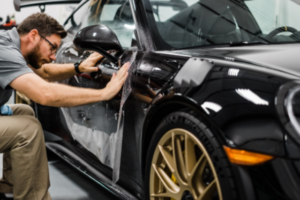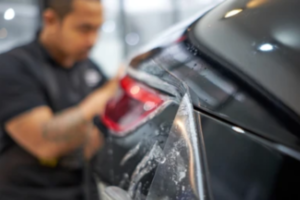Paint protection film (PPF) is famous for car owners who want to safeguard their vehicle’s paint from scratches and chips. This article will guide you through the removal of paint protection film. Read the step-by-step instructions and expert tips to ensure successful removal.
Mastering the technique of PPF removal allows you to maintain your vehicle’s pristine condition. Thus, it ensures its long-lasting beauty and helps retain its value over time. That’s why we’ve created this guide to help you navigate each step.
As we say goodbye to the old film, prepare to unveil your vehicle’s new, clean surface. Welcome a new chapter in car care and maintenance.
What is Paint Protection Film?
Paint protection film (PPF), a clear bra or clear film, is a thin, transparent layer. It is applied to vehicles’ exterior surfaces to protect them from damage. This includes road debris, scratches, chips, and other environmental hazards. In addition, it acts as a protective barrier, preserving the paintwork and keeping the vehicle looking newer.
PPF is designed to withstand the rigors of daily driving. Moreover, it provides an added defense against elements that can harm the vehicle’s paint.

As a result, it is commonly used in areas prone to impact. These areas include the front bumper, hood, fenders, side mirrors, and door edges. However, it can also be applied to other vehicle parts for additional protection.
Why Remove Paint Protection Film?
Before we start the removal process, let’s briefly discuss why you might need to remove your existing paint protection film. There are several reasons why you may need to remove paint protection film:
Damage: If the film has sustained damage, such as deep scratches or tears, it may be necessary to remove and replace it.
Wear and Tear: The film may show signs of wear and tear over time. These signs include discoloration or lifting at the edges, which can compromise its effectiveness.
Upgrading or Changing Appearance: If you want to change the look of your vehicle or upgrade to a different type of film, removing the existing paint protection film is necessary.
Maintenance and Inspection: Removing the film allows for a thorough inspection of the underlying paint surface. This enables you to address any issues or perform maintenance as needed.

How to Remove Paint Protection Film | 6 Simple Steps to Removing
If you have paint protection film (PPF) on your vehicle, that must be removed. Following the step-by-step to remove paint protection film:
Step 1: Gather the Required Tools
To get started, make sure you have the necessary tools on hand. Here’s a list of items you will need:
- Heat gun or hairdryer
- Plastic razor blade or a specialized PPF removal tool
- Isopropyl alcohol or adhesive remover
- Microfiber towels
- A mild detergent and water solution
Step 2: Prepare the Surface
Before removing the paint protection film, preparing the surface is essential. Start by washing the area with a mild detergent and water to remove dirt or debris. Next, rinse thoroughly and dry the surface with a microfiber towel. Ensuring a clean surface will make the removal process easier.
Step 3: Apply Heat
Using a heat gun or hairdryer on a low setting, apply heat to the edge of the PPF. The heat will soften the adhesive, making it easier to peel off. Keep the heat gun or hairdryer at a safe distance and move it back and forth to distribute the heat evenly.
Step 4: Peel Off the Film
Once the adhesive is sufficiently heated, start peeling off the paint protection film slowly and carefully. Use a plastic razor blade or a specialized PPF remover tool to lift the edge of the film. Pull the film back in a smooth and steady motion, applying more heat if necessary.

Step 5: Remove Adhesive Residue
After removing most of the paint protection film, you may notice adhesive residue left behind. To tackle this, apply isopropyl alcohol or adhesive remover to a microfiber towel and gently rub the residue in a circular motion. The alcohol or adhesive remover will break down the adhesive, allowing you to wipe it away quickly. Repeat this process until all residue is removed.
Step 6: Clean and Finish
To complete the process, clean the surface with a mild detergent and water solution. This will help remove any remaining residue or traces of adhesive remover.

Next, rinse thoroughly and dry the area with a microfiber towel. Once the surface is clean and dry, you can apply a fresh coat of wax or polish to restore the shine and protect the paint.
Step-by-Step Process to Repair Your Paint Protection Film | Restoring the Protection
PPF prevents damage to your vehicle’s paint from everyday wear and tear. However, the film may have minor imperfections or damage over time. Here’s a step-by-step guide on how to repair paint protection film effectively:
Clean the Area
Before beginning the repair process, ensure the damaged area is clean and free from dirt, debris, or other contaminants. Use a mild soap or automotive shampoo to clean the affected area gently. Then dry it thoroughly with a clean microfiber cloth.
Assess the Damage
Carefully examine the paint protection film to identify the extent of the damage. Is it a minor scratch, a deep gouge, or a larger section that needs attention? Understanding the type and severity of the damage will help determine the appropriate repair method.

Minor Scratch Repair
You can often address minor surface scratches with a specialized scratch repair product. Follow the product manufacturer’s instructions. Typically, this involves applying the repair solution and gently buffing it with a clean microfiber cloth. This process helps minimize the scratch’s appearance and restore the film’s protective qualities.
Deep Gouge or Larger Damage
If the damage extends beyond a minor scratch, it may require a more comprehensive repair approach. In such cases, it is recommended to seek professional assistance from a qualified PPF installer or technician. They can repair or replace the damaged section using their expertise and tools. This ensures a seamless and effective restoration of the car’s appearance.
Expert Repair or Replacement
Film removal and reinstallation may require a heat gun, trimming, or complete film replacement. First, the experts will assess the damage. Then, they will choose the most suitable method to restore the integrity and protection of the PPF. This ensures your vehicle’s paint remains safeguarded. Additionally, the repaired section blends seamlessly with the existing film, providing a seamless and cohesive appearance.
Routine Maintenance
Once the repair is complete, it is essential to continue maintaining the paint protection film. This will help prolong its lifespan and effectively safeguard your vehicle’s paint. Regularly clean the film with gentle automotive soaps or dedicated PPF cleaners.
Avoid using abrasive materials that could damage or degrade the film. You can maintain the repaired area and the entire PPF optimally by practicing proper maintenance.

Removing paint protection film may require some practice to master the technique. Take your time, work in small sections, and be patient. Remember to use the appropriate tools and follow the steps carefully to avoid damaging the surface of your vehicle.
Notable:
It’s important to note that each vehicle and paint protection film may have unique characteristics and requirements. Therefore, referring to your vehicle manufacturer’s guidelines and specific film instructions is crucial.
Furthermore, this will help you understand any variations or precautions necessary to properly maintain the paint protection film. Safety should always be a priority, so take your time, be patient, and exercise caution throughout the process.
Benefits of Removing Paint Protection Film
There are several benefits to removing paint protection film from your vehicle, including:
- Restoring the appearance of your vehicle.
- Increasing the resale value of your vehicle.
- Preventing further damage to your vehicle’s paint.
- Improving your vehicle’s aerodynamics.
- Improving your vehicle’s fuel efficiency.
Now that you know the steps to remove paint protection film, you can confidently tackle this task and maintain the pristine appearance of your vehicle.
Bottom Line
In conclusion, removing paint protection film from your car can be done successfully with the right tools and techniques. You can effectively remove the film by following the step-by-step instructions in this article and being cautious throughout the process. This can be done without causing any damage to your car’s paint.
Remember to take your time, apply heat, and use adhesive remover to eliminate residue. Then, with proper care and maintenance, your car’s paint will be ready for a new paint protection film removal. Alternatively, you can opt for other protective measures to keep your car’s paint looking its best.
FAQs
Can I remove the paint protection film without using heat?
While heat is the most effective method for removing PPF, you can use adhesive remover to soften the adhesive and carefully peel off the film. However, using heat is generally recommended for more accessible and more efficient removal.
Will remove the paint protection film damage the underlying paint of my car?
When properly installed and removed, paint protection film should not damage the underlying paint of your car. However, if the film has been on the surface for an extended period.
If it is not installed correctly, there is a slight chance that the paint may be affected. Therefore, following the proper removal techniques and taking your time to minimize any potential damage is essential.
How often should I replace my paint protection film?
The lifespan of paint protection film can vary depending on several factors. These factors include the quality of the film, environmental conditions, and how well it has been maintained over time.
Generally, PPF can last anywhere from 5 to 10 years. However, if you notice signs of wear and tear, such as discoloration, bubbling, or peeling, it is advisable to replace the film. This ensures continued protection for your vehicle’s paint and prevents any further damage.
Can I remove the paint protection film or seek professional help?
While removing paint protection film yourself is possible, it requires careful attention and patience. However, you can attempt the removal process if you are confident in your abilities and have the necessary tools.
However, if you are uncertain or concerned about damaging your car’s paint, it is recommended to seek professional help. Experienced detailers or auto body shops can provide the expertise and assistance.
How long does it take to remove paint protection film?
The time required to remove the paint protection film depends on several factors. These factors include the size of the film, its age, and the condition of the underlying paint.
Generally, it can take anywhere from a couple of hours to several hours to complete the removal process.


